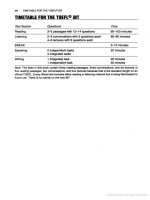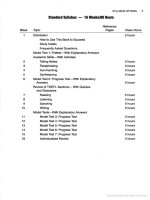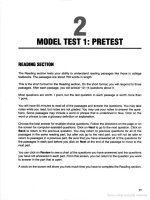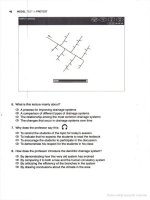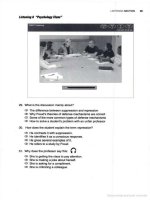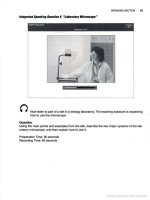Toefl ibt internet based test 2006 - 2007 part 67 potx
Bạn đang xem bản rút gọn của tài liệu. Xem và tải ngay bản đầy đủ của tài liệu tại đây (552.63 KB, 7 trang )
MOOEL TEST 71LISTENING SECTION
qg
44
. What does the professor mean when she says this:
()
<J) She is reminding the students of previous facts.
(J)
She
Is
disagreeing with the statistics.
<D
She
Is
Indicating that the eKample
Is
un
lmpo
r1anl.
$ She
Is
expressing
un
cer1ainty about Ihe information.
45. In the lecture,
th
e professor repor1s the preliminary results of
her
research. Indicale
whelher each
01
the following
Is
one of the findings. Click
In
the correct box for each
sentence.
y"
No
A Morning eKposure
for
the treatment is superior.
B A regular sleep schedule supports therapy.
C Eye damage occurs
In
only a few subjects.
0 Sessions 01 less than two hours are preferable.
E Fluorescent lighting cannot be used for therapy.
h
490
MORE
MODel TESTS
TO!<l-U._
~
G')
CD
c.:t)
46. What is the discussion mainly about?
Q;)
The theory of everything
<D Einstein's
un
ified field theory
CD
Advances in brain theory
CD) Theoretical mathematics
47. How does the professor
explain
th
e closed string?
CD
He refers the students
to
a web site.
eD He rewords the definition
In
the book.
CD
He compares it with a thin rubber balle!.
eD) He contrasts it with an open string.
48. Why does the professor say this:
n
Q;)
He does not expect the student to answer the question.
eD He does not know the answer to the question.
CD
He does not want
to
continue the debate
In
class.
eD) He does not want to Influence the woman's thlnklng.
~
49. According
to
the discussion, what reason does the man give
lor
rejecting string theory?
CD
There
may
have been errors in the mathematical calculations.
eD Strings have not been observed In a laboratOl)'.
(D
Siring theory does not prove !he theory of everythi
ng
.
(])
The experiments were oot performed oorrectly.
r
h a r
MOOEl TEST 71llSTENING
SE.CTION
4.,
so
. What can be inferred
abouithe
students?
CD
Th
ey
have not fonned opinions about t
he
theory.
CD
Th
ey
do
not agree
with
the professor's point
01
view.
eD They have reached different conclusions abouI
lh
e the<xy.
<lP
They have changed
the
ir minds during the discussion.
51. Why does the prol
eSSOf
suggest
lhatthe
students visit a web site?
CD
Th
e
textbook
does
not
have
the
IatestlnfonnaOOn
about
the
to
p
ic
lhatthey
will
debate.
CD
The web site should provide
ootectiVe
data, which they can use lor the next discussion.
CD
The professor wants the students 10 understand the history
of
the
theory
they are
studying.
CD
The site
will
prepare
the students to complete mathematical
caJculations
before
the
next class.
Please
tum
off
the
audlo
.
1lIefe
'
s.
11Hnlnute
break
between
the
Ustenlng section and
the
Spea
ki
ng
section.
righted
ater
492
MOAE
MODEL
TESTS
SPEAKING
SECTION
(')
Model Test 7, Speaking Section,
CD
10, Track 2
The
Speaking section tests your abi
li
ty to communicate
in
Eng
lish In
an
academic setting.
Dur-
ing the lest, you will be presented with
sl)(
speaking questions. The questions ask for a
response to a single
questiOn
, a conversation, a talk, or a lectu
re
.
Yo
u
ma
y take not
es
as you listen, b
ut
notes
are
not
graded.
You
may use your notes to answer
the questions. Some of the questions ask
for
a response
10
a reading passage
and
a talk or a
lecture.
The
readi
ng
passages and the questions are written, but most of the directions will
be
spoken.
Your
speaking will be evaluated on both the fluency
01
the language and
the
accuracy
01
th
e
co
nlen
t.
You
will h
ave
15-20 seconds to prepare
and
45-60 secoods
10
respond
10
each ques-
tion. Typically, a good response
will
require all of the
re
spon
se
time
but
the
answer will
be
complete
by
the
end
of the response tlme.
The
time lor the Speaking section
is
about
20
m
in
ut
es
. A
clock
on
the scr
een
will
show
you
how much time
you
have
to prepare
you
r answer and how much time
you
have
to
record
it.
)pynghled
maken 11
MODEL
TEST
7/SPEAKrl'fG
SECTIO
N
'a3
r=
-==
~
- .
".
()
Usten for a question about a famili
ar
topic.
Que
sll
on
Th
ink about a book that you have enjoyed reading.
Why
did you like it? What was especially
interesting about the book? Use specirlC details and examples to support your response.
Preparation Time:
15 seconds
Recording Time:
45
seconds
494
MORE
MODEL
TESTS
1 • .",tJUDt
*Wl.
DueIIJOII
2 "
F.,.,,.
" '
'''
1O[<l-I'i9M''''II
~:; \
•
0-'_,,,,.
n Listen
lor
a question that asks your opinion about a lamiliar topic.
Qu
• • t
lo
n
Some people think
th
at
it
is better
10
travel
as
pa
n
01
a
to
ur group when they are visiting a
lor
-
eign country. Other people prefer
to
make their own travel plans
so
that they can travel lnde-
pondonlly
.
Wh
i
ch
approach do you think Is
better
and
why? Use s
pec
if
ic
reasons
and
examples
to
support your opinion.
Preparation Time:
15 seconds
Recording Time: 45 seconds
ngh
ma
r
4118
MORE
MOOEl
TESTS
Integrated
Speaking
Questlall
tf
"Pa",.s"
Read a shan passage and then listen
10
part of a tecture on the same topic.
Readfng
lime
: 45 seconds
pangea
Pfate tectonics
assumes that the Earth's rigid outer fayer is comprised of a number of slabs
called plates, which are constantly in motion, changing the position of land masses and
seascapes relative
to
each other throughout history. The plates move slowly but continu-
ously
at about the rate of 2 inches evary year. The movement 01 the plates thamselves may
be caused by the unequal distribut
io
n
01
heat and pressure below them.
Very
hot mate
ri
al
deep within the mantle, that
Is
, the layer
01
rock
inside the Earth, moves upward while the
cooler layer descends
In
to t
he
mantle, putting the
ou
ter crust
01
the continents in motion.
Several large plates
Include
an
entire continent with its surroundi
ng
seafloor; however, the
boundaries of the plates
do
no
t co
rr
espond precisely with the seven continents that we rec-
ognize
today.
n Now listen
10
part
01
a lecture in a geography class. The prolessor is talking about
Pangea.
Ques
tion
Explain how plale tectonics retales to Ihe theory of continenlal
dn'h
.
Preparation
TI
me:
30
seconds
Recording
lime
: 60 seconds

